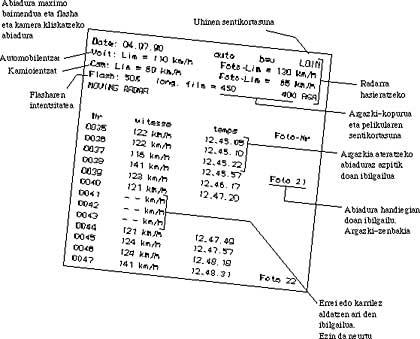The automotive radar, road pattern

On the highways and highways it is usually required to put radar controls and fines for not respecting traffic signals. When you wait until you stop for excess speed and get a fine on the edge of the track, you will see that the other cars pass faster than you and there is nothing more rabid. These radar posts, however, have to be stopped to detect speed, are fixed positions.
Once this position is known and passed, the car driver can feel like going faster. In short, the contribution of radars that need a fixed position to road safety is debatable. On the one hand, people identify them and on the other, they can only work on a limited stretch of the road. To overcome all these obstacles, mobile radars have been manufactured. The police ride them in cars, but in normal cars that no one can appreciate.
The most advanced radar today is the Multanova 6F model that makes the Swiss house Zellweger. They are mounted in any car, but if you want also on a tripod to work as a fixed post.
The entire electronic part of the radar is in the trunk of the car and the license plate only comes a little bit the head of hyperfrequency. In addition, this composite material head will be dissipated. The flash and photo camera are located on the back deck of the car.
In order for the mobile radar mounted in the car to measure the speed of the vehicles, you must first know the speed at which you go. For this purpose it has a taquometer mounted at the exit of the gearbox, formed by sensors similar to those used in the braking system ABS. Thanks to the information received by these pickers, the car calculator takes into account the speed of itself and, adding the measure by waves, calculates the speed of the other vehicle.

By means of the output pickers of the gearbox, the error that the radar can present in the calculation of its own speed is less than 1%. Regarding the hyperfrequency head, the only novelty is its orientation. The frequency of the waves it emits is standard 24,125 GHz. With more than 24 billion oscillations per second, its orientation allows to measure the speed of trucks as well as that of cars.
This is not so easy to get on fixed radars. Depending on the type of vehicle, the distance to the ground is usually different and in some cases, if the radar wave beam is reflected at the end of the car, in others the wheels of the truck can be reflected. When the wave beam is reflected by the wheels, the radar does not measure the speed well. If the wave beam hits the bottom of the wheel, the radar marks a very low speed and if the wheel hits above the shaft, twice what it really has. In this case, therefore, the radar can not be used.
Multanova 6F
The most worked part of the model is its calculator. When fixed in one place, it can measure speeds from 0 to 240 km/h and even higher. To calculate the speed very precisely does not make a single measure, but 60. Once all these measurements have been made, the calculator only accepts if they are at least 20 equal. In addition, it automatically detects the arrival address of the vehicle object of study and can simultaneously control both directions of circulation. Therefore, when you drive your car, you don't know if the radar is going your way or if it comes to you in the opposite direction.
Due to the difference of intensity of the reflected waves, it can be differentiated if the one that circulates is a truck or not, and depending on it, two speed limits can be established: 130 km/h for cars (on highway) and 90 km/h for trucks, for example.
Multanova 6F
The radar has the same operating possibilities in rest or in roaming. Urges the driver to establish a speed limit at the time of the commissioning of the device. On motorways and motorways the most normal is to establish a speed of 110 km/h for cars. In turn, it applies the speed of operation of the flash, which for possible errors of measure is something greater: 130 km/h for cars and 100 km/h for trucks on motorways.
The radar is ready to operate, but for this purpose it is necessary to move the radar itself at a constant approximate speed. Let's think it's 100 km/h. When other cars pass the radar they can exist: Circular at a speed of less than 110 km/h, circular between 110 and 130 km/h and circular at a speed of over 130 km/h. In the first case the radar does not indicate anything. In the second case, the speed is only indicated in the box attached to the car panel (see figure) and the flash and camera are fired at a speed of over 130 km/h. In the latter case, the calculator records in the photo film the day, time, speed and the photo number through the electroluminescent recorder.
To measure speeds, the displacements of radar and the vehicles detected must be parallel and the displacements can be direct or curved. If the vehicle is diverted to advance or brake sharply, the radar cannot measure the speed. That is why in his painting does not mark any speed.
That said, this radar control the vehicles of both senses on the road, will be less accident!






